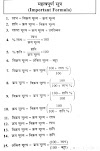प्रायिकता probability
- probability
| 1. |
1 से 20 नंबर के टिकट मिश्रित होते हैं और फिर एक टिकट यादृच्छिक पर खींचा जाता है। इस संभावना की क्या संभावना है कि टिकट के पास संख्या है जो 3 या 5 का एक बहुमूल्य है?
| ||||||||||||||||||||||
Answer: Option D
Explanation:
Here, S = {1, 2, 3, 4, ...., 19, 20}.
Let E = event of getting a multiple of 3 or 5 = {3, 6 , 9, 12, 15, 18, 5, 10, 20}.
|
| 2. |
एक बॉक्स में, 8 लाल, 7 नीले और 6 हरी गेंदों हैं। एक गेंद बेतरतीब ढंग से उठाया है। क्या संभावना है कि यह न तो लाल और न ही हरे रंग की है?
| |||||||||||||||||||||||||||||
Answer: Option A
Explanation:
Total number of balls = (8 + 7 + 6) = 21.
|
| 3. |
एक बैग में 2 लाल, 3 हरे और 2 नीले बॉल हैं। दो गेंद यादृच्छिक पर खींचा जाते हैं क्या संभावना है कि गेंदों में से कोई भी नीला नहीं है?
| ||||||||||||||||||||||||||||||||||||||||||||
Answer: Option A
Explanation:
Total number of balls = (2 + 3 + 2) = 7.
Let S be the sample space.
Let E = Event of drawing 2 balls, none of which is blue.
|
| 4. |
एक पासा के दो फेंकने से राशि 9 होने की संभावना क्या है?
| |||||||||||||||||||||||||
Answer: Option C
Explanation:
In two throws of a dice, n(S) = (6 x 6) = 36.
Let E = event of getting a sum ={(3, 6), (4, 5), (5, 4), (6, 3)}.
|
| 5. |
तीन निष्पक्ष सिक्कों को फेंक दिया जाता है। अधिकतर दो प्रमुखों पर होने की संभावना क्या है?
| ||||||||||||||||||||||
Answer: Option D
Explanation:
Here S = {TTT, TTH, THT, HTT, THH, HTH, HHT, HHH}
Let E = event of getting at most two heads.
Then E = {TTT, TTH, THT, HTT, THH, HTH, HHT}.
|








Post a Comment
0 Comments